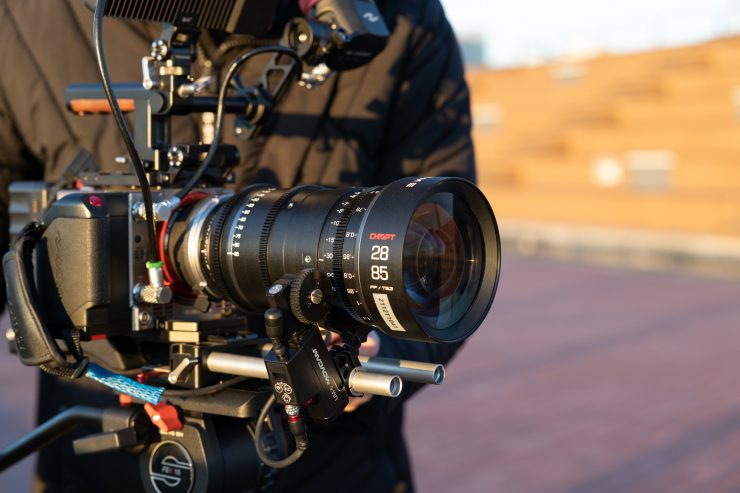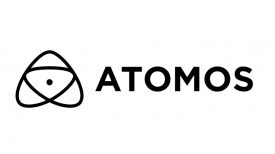
The CHIOPT SLASHER is a new series of full-frame cine prime lenses with macro functionality. The lenses will initially be available in the following focal lengths:
- 24mm T2
- 35mm T2
- 50mm T2
- 75mm T2.8
- 100mm T2.8

According to CHIOPT, all of the lenses have minimal distortion, excellent dispersion control, a uniform defocus light and shadow, and a smooth light spot. The lenses come in a PL stainless steel mount, however, CHIOPT will be releasing PL-EF/E/RF adapters that you can use to put them on a wide range of cameras from different manufacturers.

Please be mindful that the lenses I will be reviewing are pre-production versions and there may well be some improvements to the shipping versions based on user feedback and testing.
The lenses are also claimed to work with CHIOPT’s 1.7x extender.
Macro Functionality

What makes the CHIOPT SLASHER series unique is that, at least to my knowledge, they are one of the only affordable sets of cine prime lenses with macro capabilities on the market.

Now, the caveat with most specialized macro lenses is that while you can use them as normal prime lenses, they often don’t perform well in that capacity.
Close Focus Ability

All of the focal lengths were designed to be able to focus fairly close to your subject. The magnification varies depending on the focal length.

So, how close can you focus with the various focal lengths? Well, below you can see:
| MOD | |
| 24mm T2 (0.21x) | 9.05″ / 23cm |
| 35mm T2 (0.33x) | 9.05″ / 23cm |
| 50mm T2 (0.49x) | 9.44″ / 24cm |
| 75mm T2.8 (1x) | 10.62″ / 27cm |
| 100mm T2.8 (1x) | 11.41″ / 29cm |
Below you can see a MOD comparison between the CHIOPT SLASHER 24mm T2 and the Sirui Jupiter 24mm T2 Macro Cine lens.
| CHIOPT SLASHER 24mm T2 | Sirui Jupiter 24mm T2 | |
| MOD | 9.05″ / 23cm | 9.4″ / 23.87 cm |
Below you can see a MOD comparison between the CHIOPT SLASHER 24mm T2 and the DZOFilm Gnosis Macro Prime 24mm T2.8
| CHIOPT SLASHER 24mm T2 | DZOFilm Gnosis 24mm T2.8 | |
| MOD | 9.05″ / 23cm | 6.1″ / 15.5 cm |
Build Quality

The CHIOPT SLASHER lenses are reasonably well made. The outside of the lens casing is a hard metal and it has been designed in a matte black finish to avoid light reflecting off it. The lenses are claimed to be dust and rain proof.
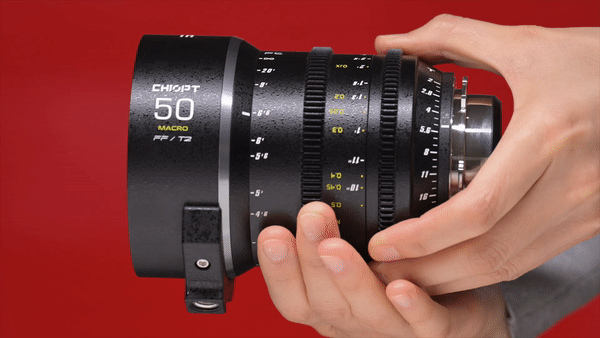
The biggest issue is when it comes to consistency. The focus ring resistance and smoothness varied quite a lot between the different focal lengths. For example, on the 35mm, it was nice and smooth and consistent, but on the 100mm it wasn’t as smooth and there was a noticeable noise when moving it between 1′ 9″ and 2′ 6″. The 50mm also had a similar issue where the focus ring made a noise between 10″ and 2′.
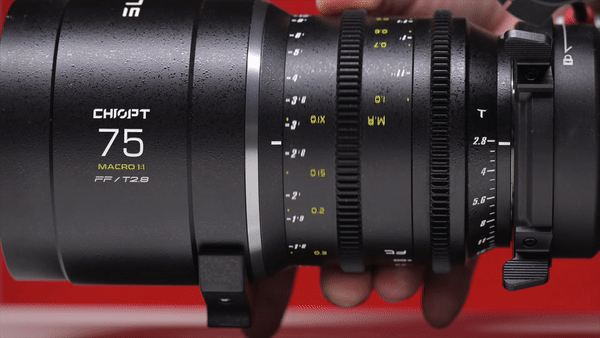
The focus rotation is 288-degrees which is a slightly odd number, however, it is so close to 300 degrees that I doubt most operators could tell the difference. If you are pulling focus by hand you will find it virtually impossible to go from the minimum focus to the maximum focus point, but this is true of most cine primes and zooms.

Just like the focus rings, the iris rings smoothness and consistency varied between the various focal lengths. The 100mm had a lot less resistance than the other lenses and it made a noticeable noise when you turned it. The iris ring on the 35mm was stiffer than its focus ring but on some of the other lenses, this wasn’t the case.
I also found that on some cameras with PL mounts the lens would wobble slightly. Again, these were pre-production lenses so I would expect these issues to be sorted out before they ship.

There is a built-in lens support adapter that takes a 1/4-20″ thread.

I am not the biggest fan of having the name SLASHER written all over the lenses. I certainly think CHIOPT could have come up with a more appropriate and better name. In my personal opinion, the name cheapens the brand.

I know these are affordably priced cine lenses, however, it would still be nice to see more consistency in the operation of the lenses.
Size & Weight

The CHIOPT SLASHER Cine prime lenses are all different weights and lengths. They do have some weight to them, especially the 75mm T2.8 and the 100mm T2.8.

I independently weighed them and this is what I found (please note that these are not exact measurements):
| WEIGHT | |
| 24mm T2 | 1.2 kg / 2.64 lb |
| 35mm T2 | 1.2 kg / 2.64 lb |
| 50mm T2 | 1.2 kg / 2.64 lb |
| 75mm T2.8 | 1.7kg / 3.74 lb |
| 100mm T2.8 | 1.9kg / 4.18 lb |
Below you can see how that weight compares to the Sirui Jupiter T2 Macro Cine Prime Lenses.
| WEIGHT | |
| CHIOPT SLASHER 24mm T2 | 1.2 kg / 2.64 lb |
| Sirui Jupiter 24mm T2 | 1.25 kg / 2.75 lb |
| CHIOPT SLASHER 35mm T2 | 1.2 kg / 2.64 lb |
| Sirui Jupiter 35mm T2 | 1.15kg / 2.53 lb |
| CHIOPT SLASHER 50mm T2 | 1.2 kg / 2.64 lb |
| Sirui Jupiter 50mm T2 | 1.06 kg / 2.33 lb |
Below you can see how that weight compares to the DZOFilm Gnosis Macro Prime Lenses.
| WEIGHT | |
| CHIOPT SLASHER 24mm T2 | 1.2 kg / 2.64 lb |
| DZOFilm Gnosis 24mm T2.8 | 1.26 kg / 2.78 lb |
| CHIOPT SLASHER 35mm T2 | 1.3 kg / 2.86 lb |
| DZOFilm Gnosis 32mm T2.8 | 1.46 kg / 3.22 lb |
| CHIOPT SLASHER 50mm T2 | 1.2 kg / 2.64 lb |
| DZOFilm Gnosis 65mm T2.8 | 1.47 kg / 3.24 lb |
| CHIOPT SLASHER 75mm T2.8 | 1.7kg / 3.74 lb |
| DZOFilm Gnosis 95mm T2.8 | 1.28 kg / 2.82 lb |
| CHIOPT SLASHER 100mm T2.8 | 1.9kg / 4.18 lb |

The lenses are going to be better suited for use with digital cinema cameras rather than mirrorless hybrids due to their size and weight.
Markings

The lenses have markings on both the operator and non-operator sides.

The markings on the lenses are generally ok, but I did discover some inconsistencies. The infinity marks on the operator and non-operator sides didn’t line up correctly on the 35mm T2. On all the other lenses they did.

At least in my opinion, I would have preferred to have seen slightly clearer markings on the lenses, especially for the macro magnification as it is a little too vague for my liking.

As a comparison, above you can see how the DZOFilm Gnosis Macro Prime Lenses are marked.
Who is CHIOPT?
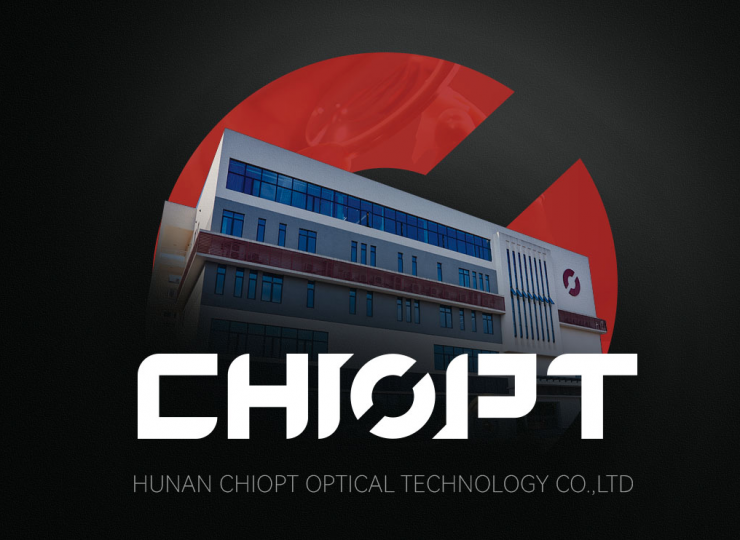
CHIOPT is a Chinese company that has been around since 2012. They mainly specialize in making industrial and security lenses. In the last year or two, they have branched out into making cine lenses.

I have reviewed both 28-85mm T3.2 and 75-250mm T3.2 zooms on the site before.
No Breathing?
I tested out the lens by doing large focus throws, and while there is some breathing (especially on the 75mm and 100mm) it is reasonably well contained. I personally don’t like focus breathing as it can be very distracting. It is good to see that most budget-friendly cine lenses have minimal amounts of lens breathing. You will always see a lot more breathing at the macro level than when shooting objects that are further away.
No lens technically has zero breathing, but very good cinema glass has such minimal amounts that it is virtually impossible to see. What you will normally see is some perspective shift which is normal when refocusing a lens.
Image shift is the change in location of a fixed point after a focus rack. It should be in the same spot after you rack focus.
Perspective shift is the focal length of the lens being modified by the movement of the optics. A slight change in focal length may happen if there is a floating element that moves and is not properly corrected for in the design. Certainly, the great majority of lenses have this issue. It’s also tenths of a mm so not overly noticeable.
Focus breathing is a change in image size so the size of the object will get larger as it moves out of frame. That is reproduction size.
In summary, perspective shift is the effective focal length change (angle of view change) and focus shift is the reproduction size of the object changing as focus moves. Think of it like Macro. A macro lens can be 1:1 life-size reproduction but as you focus it can change the reproduction size. That is focus shift from intentional breathing design. The angle of view is not overly affected in that case because it is flat field focus. On spherical lenses, the angle of view does change slightly as you focus rack thus making for perspective/angle of view shift.
Fall off, Image Coverage & Vignetting

As the lens covers a 43.5mm image circle, when you use it on a full-frame-sized sensor you get very good illumination across the entire image.
I didn’t see any vignetting when shooting 6K 17:9 full-frame on the Kinefinity MAVO LF.
Sharpness
The growing trend that is common with quite a few of the affordable cine zooms and primes these days is to come up with something that is a little more vintage, and that sometimes comes at the expense of sharpness. I was curious to see if the CHIOPT followed that trend. Above you can see how the 24mm T2 performs when used at various T stops. All of the sharpness tests were captured in 6K DCI.
The lens is pretty sharp even when used wide open at T2. At T4, it does improve. For a 24mm T2 lens, I was surprised at how sharp it was.
Above you can see how the 35mm T2 lens performs when used at various T stops.
I found that at 35mm the lens was nice and sharp when used wide open at T2. Once you start stopping the lens down sharpness does improve slightly as you would expect.
Above you can see how the 50mm T2 lens performs when used at various T stops. Again, just like with the other focal lengths, it was very sharp when used wide open.
Above you can see how the 75mm T2.8 lens performs when used at various T stops. At T2.8 is is very sharp and shows a lot of fine detail.
Above you can see how the 100mm T2.8 lens performs when used at various T stops. AGain, just like with all of the other focal lengths, the lens is nice and sharp, even when used wide open.
Lens Flare
The lenses all have different flare characteristics. I personally prefer the flare from the 24mm and 35mm.
Lens flare is very much a personal thing and whether you like the flares this lens produces only you will know.
Chromatic Aberration
Something you don’t want when shooting with macro lenses is chromatic aberration. The lenses don’t have a lot of real-world visible chromatic aberration. If you zoom into the image by 300% when used wide open at T2.8 you can see a very, very small amount of color fringing on reflective surfaces and over-exposed areas. The small amount of chromatic aberration is impressive for lenses at this price.
Bokeh
Nice bokeh is something everybody craves. The bokeh produced is reasonably round and there are no signs of onion rings. I quite liked the out-of-focus areas I could get and the separation the lenses were able to achieve.
Distortion

I did find that the 24mm has a tiny bit of barrel distortion, but it was very well controlled.
Color Tone

The CHIOPT SLASHER primes are fairly neutral when it comes to color tone. They may lean a little more toward cooler tones, but I wouldn’t say they are as cool as a Zeiss. The lens isn’t too clinical, especially when used wide open. What look you actually prefer from a lens is entirely going to come down to personal choice. What was nice to see is that all of the lenses in the series shared a common color tone. While they may have slightly different flare characteristics, they all worked well together.

The color tone of a lens is really something you should look at closely if you are going to be using both prime and zoom lenses from different manufacturers. Certain prime and zoom lenses work better together than others. What will work for you will also depend on what camera you are using.
Real World Thoughts

The CHIOPT SLASHER Macro Cine Primes would be right at home on cameras such as the Sony FX6, FX9, VENICE, RED V-Raptor, ARRI ALEXA Mini LF, ARRI Amira, ARRI ALEXA 35, Canon C500 Mark II, Kinefinity MAVO LF, EDGE, etc. You could also use them on smaller-sized mirrorless hybrids if you are prepared to deal with their weight and size.

They really are specialized lenses and they perform a lot better as macro lenses than general primes. You can some really tight and interesting macro shots using the lenses. The lenses are all nice and sharp when used in a Macro capacity, even wide open.

I went and took some shots with the lenses and a Kinefinity MAVO LF to see how they performed in the real world.
Above you can see some footage captured with the lens. I was primarily wanting to see what it looked like at various focal lengths, the macro capabilities, and if it could be used wide open. I haven’t added any sharpness in post so you can see exactly what you get.

The lenses are generally easy to operate and use, however, as I mentioned earlier in the review, the mechanics are not consistent across the focal ranges.

The overall optical performance of the lenses is pretty good, especially when used as macro lenses. They are sharp, have no chromatic aberration and they generally have nice bokeh. However, as I mentioned earlier, they don’t perform as well as general-purpose primes.

The biggest problem CHIOPT faces is that they are still a relatively unknown company and they don’t have a long history of making cine lenses. Without having previous brand recognition it will always be hard to convince potential customers to buy your product. In saying that, you should never judge a book by its cover and you should always judge a product on its merits and not based on a brand name.
CHIOPT now has two full frame zoom lenses and 5 prime lenses, so that is a good start in building up a portfolio of cine lenses and getting your name out in the market, however, I would still like to see them make a set of regular primes.
Specifications

Price & Availability
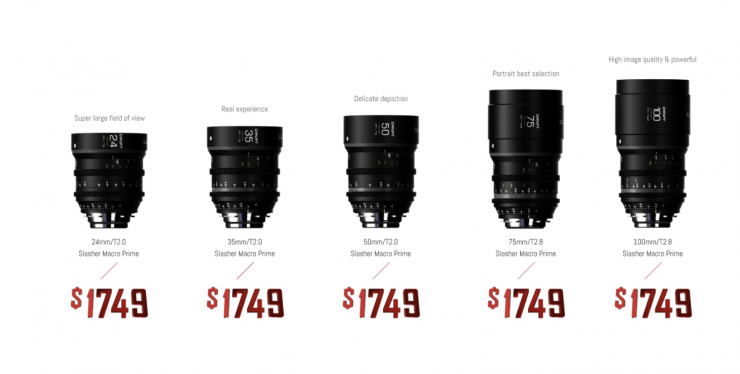
The CHIOPT SLASHER Macro Cine Primes retail for $1,749 USD each. This makes them pretty competitively priced and very affordable for full frame cine prime lenses.
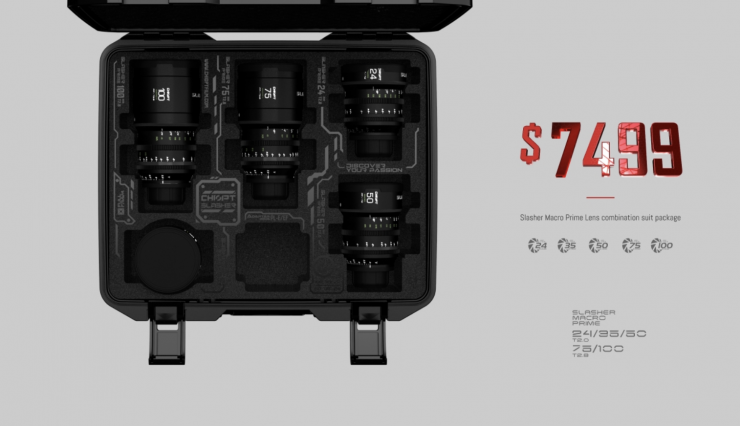
You can also buy the 5-lens set for $7,499 USD.

The case the 5-lens set comes in is nicely made and there are cut-outs for all of the focal lengths, plus a space for some accessories.
Competition

There is only a handful of cine prime lens sets on the market that have macro capabilities.
The closest competition to the CHIOPT SLASHER series would be the Sirui Jupiter T2 Full Frame Macro Cine 3-Lens Set (PL Mount). This set consists of 24, 35, and 50mm T2 lenses and it retails for $2,799 USD.
The lenses have a close focus ability of 9.4″.
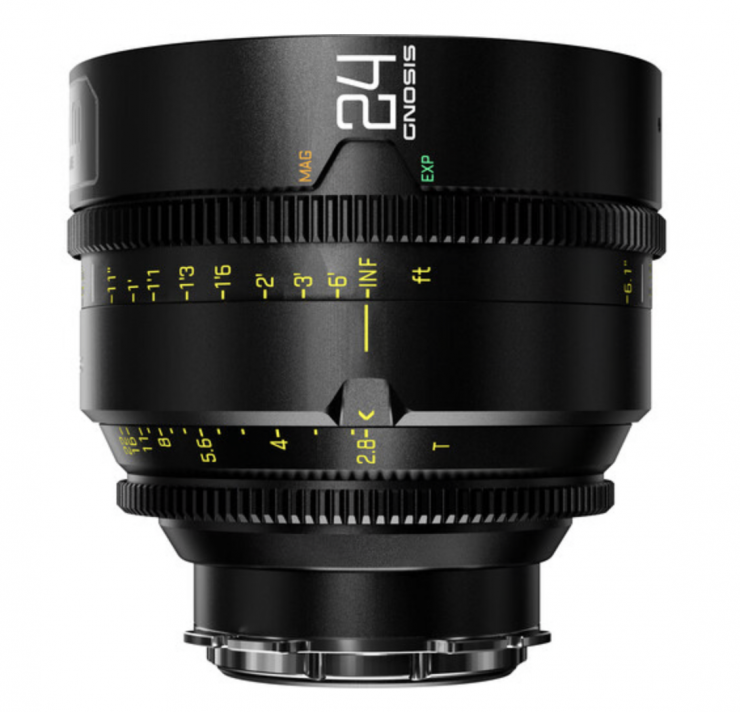
Other competition comes from the DZOFilm Gnosis Macro Prime Lenses which feature up to 1:25 magnification. Those lenses come on focal lengths of 24mm, 32mm, 65mm and 90mm and they come in ARRI LPL mount, but DZOFilm also includes user-interchangeable ARRI PL and Canon EF mounts.
The DZOFilm Gnosis Macro Prime Lenses are considerably more expensive than the CHIOPT SLASHER series and they retail for $5,389 USD each. You can almost buy the entire set of CHIOPT SLASHER lenses for less than the cost of single DZOFilm Gnosis Macro Prime.
The benefit the DZOFilm Gnosis Macro Prime Lenses have over the CHOIPT and Sirui options is that they can focus closer.
Conclusion

In the last few years, the market has been flooded with more affordable cine lenses, which is a good thing for the end user because competition is intense and prices have continued to fall. The downside to this is that deciding what lenses are right for you has become harder and harder given all the options that are available.

I am glad CHIOPT decided to do something slightly different, in saying that, making a set of macro cine prime lenses is not something that hasn’t been done before. However, CHIOPT has made a comprehensive set of 5 lenses which no one is doing at this price, but in saying that, macro primes are a very niche item.

The lenses are optically sound and they are solidly made for options at this price. If you are looking for a very affordable set of macro cine primes then they are certainly worth considering.






















